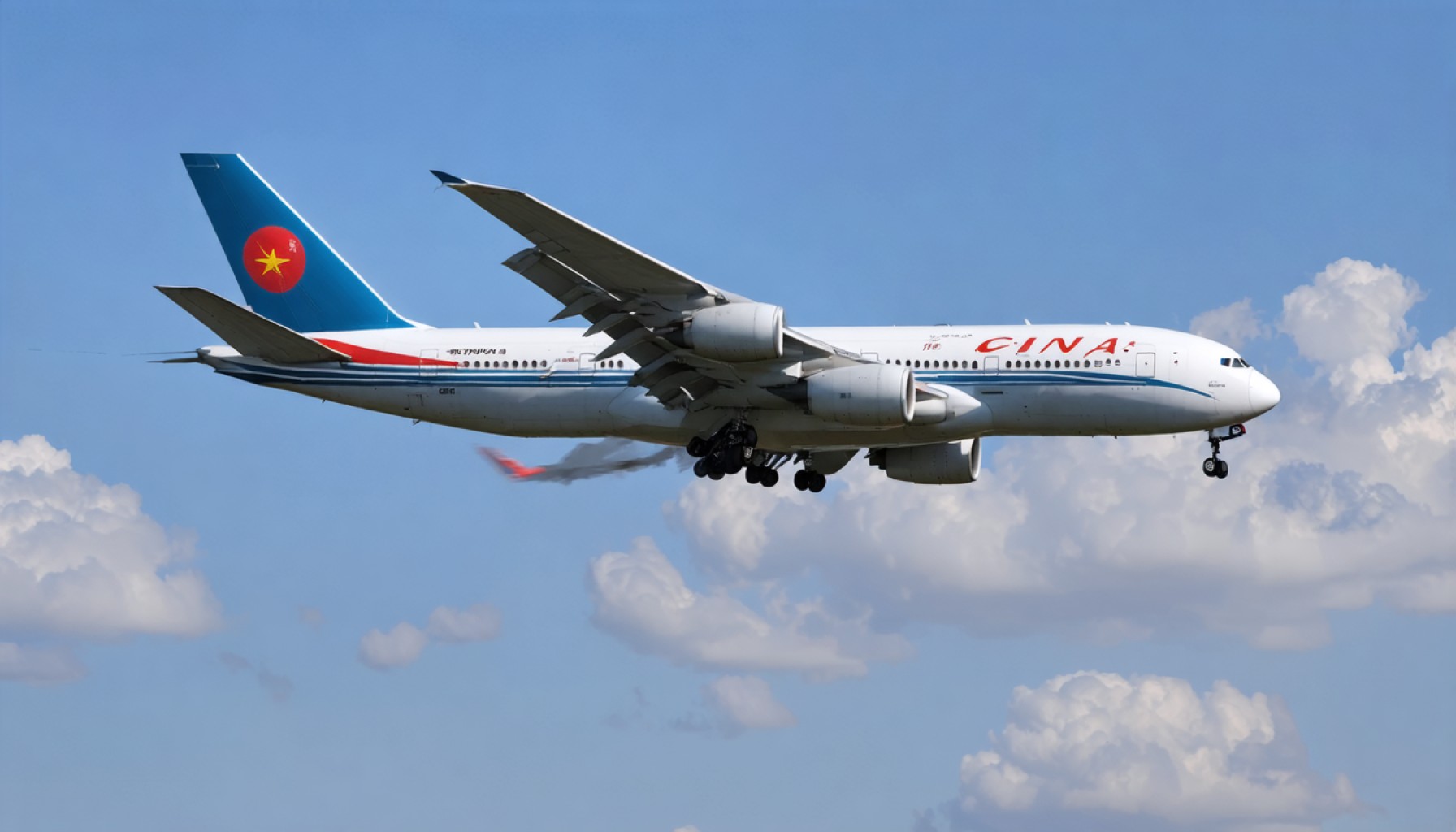- Geopolitical tensions between the U.S. and China are impacting global aviation, with potential opportunities for Indian airlines.
- Chinese airlines are avoiding Boeing purchases due to U.S. tariffs, leaving approximately 111 Boeing jets unclaimed, which could benefit Akasa Air and Air India Express.
- Indian carriers have the financial capacity to acquire and adapt these “white tail” aircraft, previously intended for Chinese airlines.
- Air India Express has historically utilized these opportunities, acquiring 25 aircraft last year.
- Operational challenges arise for Akasa Air due to plane delays, but redirected capacity could stabilize their operations.
- The tension affects Airbus too, as demand from Chinese carriers shifting away from Boeing grows.
- Overall, this situation could give Indian airlines a competitive edge amid political and commercial volatility.
The skies above India may soon witness a fleet expansion, fueled not by ordinary market dynamics, but by geopolitical tension. As the standoff between the United States and China intensifies, unexpected consequences ripple through the aviation world, offering Indian airlines a potential windfall.
Recent edicts from Beijing, a direct response to heightened U.S. tariffs, instruct Chinese carriers to steer clear of Boeing purchases. This political maneuver places approximately 100 Boeing 737 MAX jets and 11 Boeing 787 Dreamliners, initially earmarked for Chinese skies, into a peculiar state of limbo. These are the very aircraft models sought after by burgeoning Indian airlines, namely Akasa Air and Air India Express.
As the shadow of the U.S.-China trade feud spreads, it casts a faint glimmer of opportunity towards South Asia. Industry insiders hint at the likelihood of “white tails”—jets assembled yet unclaimed by their initial buyers—finding new homes within Indian fleets. Air India Express has historically capitalized on these serendipitous opportunities, incorporating 25 such aircraft last year alone. The unique configuration of these jets, often tailored for another client, becomes a canvas for flexibility and adaptability for their new operators.
Not merely beneficiaries of happenstance, Indian airlines possess the financial muscle to seize these opportunities. The Tata-owned Air India Express and the fledgling Akasa Air are primed to absorb additional aircraft, equipped to adapt and grow amidst a landscape replete with challenges and rewards.
However, the domino effect of this aviation drama extends beyond aircraft allocation. Boeing’s recent setbacks disrupt more than mere schedules. For Akasa Air, delays exacerbate operational discord; its cockpit crews find themselves grounded, awaiting planes that remain elusive. As Akasa maneuvers through these turbulent skies, the promise of redirected capacity could stabilize its flight path, ensuring its pilots don’t just man idle cockpits but command active routes.
The stakes are high, and the effects of these changes resonate globally. As Airbus experiences a surge in demand from Chinese carriers pivoting away from Boeing, it too must deftly balance its manufacturing outputs to meet these new demands.
Meanwhile, the broader aviation industry holds its breath, caught between the clashing titans of global trade. It’s a precarious dance played out in boardrooms and production lines worldwide, as both Boeing and its European counterpart, Airbus, strive to navigate these choppy political waters.
For now, the possibility of bolstered fleets offers Indian carriers a competitive edge in an increasingly crowded airspace. How they manage this windfall could redefine their trajectory in the regional aviation arena. Yet as they prepare for potential growth, the underlying tension between two of the world’s superpowers remains a sobering reminder of the volatile intersection between politics and commerce.
The Unexpected Winners in the U.S.-China Trade Standoff: How Indian Airlines Stand to Gain
Expanded Opportunities for Indian Airlines
In the ongoing geopolitical chess game between the United States and China, the global aviation industry is witnessing significant shifts that present strategic opportunities, particularly for Indian airlines. This article delves deeper into the implications and explores how Indian carriers can capitalize on these developments.
The Strategic Shift in Aircraft Distribution
1. Availability of White Tail Jets: As Chinese airlines reduce their reliance on Boeing aircraft due to geopolitical pressures, Indian airlines stand to benefit from the increased availability of “white tails.” These are completed aircraft awaiting new buyers. Air India Express has already demonstrated a knack for acquiring such jets.
2. Advancements in Indian Aviation: The Indian aviation market is poised for significant growth, with airlines like Akasa Air and Air India Express ready to expand their fleets. This shift is accelerated by the availability of advanced Boeing models like the 737 MAX and the 787 Dreamliner.
Impacts on Operational Dynamics
– Alleviating Operational Delays: For Akasa Air, having additional aircraft will help to reduce operational delays, keeping cockpit crews engaged rather than idle. This can enhance both employee morale and operational efficiency.
– Marketplace Competition: Indian airlines will gain a competitive advantage by expanding their fleets quickly during this geopolitical shift, filling gaps left by other carriers struggling to keep up with new market dynamics.
Real-World Use Cases and Industry Insights
– Regional Expansion: The surplus of Boeing aircraft can be used to expand regional routes, particularly in underserved markets across Asia. Increased connectivity will bolster India’s position as a leading aviation hub in the region.
– Partnerships and Collaborations: Indian airlines can explore partnerships with Boeing to acquire these “white tail” jets at potentially reduced rates, leveraging long-term contracts and favorable financing.
Market Trends and Predictions
– Market Forecasts: The Indian civil aviation market is expected to grow substantially, with passenger traffic potentially doubling over the next decade according to industry experts. This growth is driven by rising income levels, improved infrastructure, and increased tourism.
– Competitor Responses: As Airbus sees an uptick in demand from Chinese airlines, its manufacturing capabilities may be stretched, creating ripples across the global aircraft supply chain and affecting delivery timelines.
The Bigger Picture: Navigating a Geopolitical Landscape
– Security and Sustainability: As geopolitical friction increases, Indian airlines must be vigilant about supply chain stability and fuel efficiency to navigate potential disruptions.
– Sustainability Goals: Adopting newer, more fuel-efficient aircraft like the 737 MAX and 787 Dreamliner aligns with global sustainability goals, reducing carbon emissions and operational costs.
Actionable Recommendations for Indian Airlines
– Strategic Fleet Expansion: Prioritize the acquisition of versatile aircraft models to provide flexibility in route planning and strategic expansion.
– Investment in Pilot Training: Ramp up investment in crew training to ensure readiness for new aircraft types, optimizing deployment speed.
– Building Supplier Relationships: Forge strong ties with aircraft and parts manufacturers to secure better deals and maintain a steady supply of necessary components.
Conclusion
Indian airlines are uniquely placed to leverage the geopolitical shifts in aviation due to the U.S.-China trade standoff. By capitalizing on the availability of Boeing aircraft, expanding strategically, and ensuring robust operational practices, they can strengthen their market position and emerge as leaders in the growing Asian aviation market.
For more insights on global trade dynamics and aviation trends, visit Boeing and Airbus.


